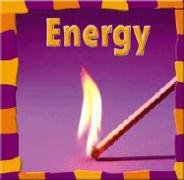-
Energy
Joseph Midthun, Samuel Hiti
Paperback (World Book, Inc., Jan. 1, 2012)This graphic nonfiction book introduces energy, including its forms and uses. Each of the ten Building Blocks of Physical Science volumes features a whimsical character to guide the reader through a physical science topic. The science is as sound as the presentation is fun! The volumes include a glossary, an additional resource list, and an index. Several spreads in each volume are illustrated with photographs to help clarify concepts and facts. R
R
-
Energy
Matt Mullins
Paperback (Scholastic, Sept. 1, 2011)A True Book-Physical Science Whether you're an aspiring inventor or an everyday science buff, you've probably created your own experiments to uncover the truth about the forces of physical science. Now you can delve deeper into the topics of electricity, motion, gravity, and more with these titles that are perfect for the budding scientist in you. T
T
-
Energy
Joseph Midthun, Paul Kobasa
Hardcover (World Book, Inc., July 1, 2012)What is energy, and what can it do? Follow your cartoon guide in Energy as he travels through cities, turbines, dams, and even the soil to find out! Through bright and colorful comic-book-style pages, kids can read about different forms of energy and how energy is stored. They will have fun exploring how people use energy, and how energy consumption can be reduced. World Books Building Blocks of Physical Science series makes complex STEM lessons exciting for young learners with a primary reading level grades 3 through 5. Each nonfiction book pairs humor and action with scientifically accurate information to make even the most difficult topics amusing and easy to understand. Kids will eagerly learn the fundamentals of physics through such volumes as Energy, Magnetism, and Matter and How It Changes. Helpful glossaries and indexes in each volume direct readers to the most important terms and topics. Materials for further exploration are suggested in lists of additional resources. Give budding scientists a head start with World Books fun Building Blocks series!
-
Energy
Joseph Midthun
eBook (World Book, Inc., May 31, 2018)What is energy, and what can it do? Follow your cartoon guide in Energy as he travels through cities, turbines, dams, and even the soil to find out! Through bright and colorful comic-book-style pages, kids can read about different forms of energy and how energy is stored. They will have fun exploring how people use energy, and how energy consumption can be reduced. World Book’s Building Blocks of Physical Science series makes complex STEM lessons exciting for young learners with a primary reading level grades 3 through 5. Each nonfiction book pairs humor and action with scientifically accurate information to make even the most difficult topics amusing and easy to understand. Kids will eagerly learn the fundamentals of physics through such volumes as Energy, Magnetism, and Matter and How It Changes. Helpful glossaries and indexes in each volume direct readers to the most important terms and topics. Materials for further exploration are suggested in lists of additional resources. Give budding scientists a head start with World Book’s fun Building Blocks series!
-
Energy
Jacob Batchelor
Paperback (Children's Press, Feb. 1, 2019)Learn how energy affects the movement of objects through the air, the warmth we feel on our skin when the sun shines, and many concepts in between.A True Book: Physical Science allows readers to find answers to puzzling questions as well as discover how people have used physical science to make countless innovations throughout history. This series includes an age appropriate (grades 3-5) introduction to curriculum-relevant subjects and a robust resource section that encourages independent study. Readers will also conduct energy experiments and find out how humans have learned to harness energy in different ways. R
R
-
Energy
Andrew Dean Foland Ph.D.
eBook (Chelsea House Publications, Aug. 1, 2007)Energy is the central concept of physics. Unable to be created or destroyed but transformable from one form to another, energy ultimately determines what is and isn't possible in our universe. This book gives readers an appreciation for the limits of energy and the quantities of energy in the world around them. This fascinating book explores the major forms of energy: kinetic, potential, electrical, chemical, thermal, and nuclear.
-
Energy
Suzanne Barchers
eBook (Teacher Created Materials, Nov. 15, 2014)Energy comes from many sources. It comes from the sun, wind, water, and more. Learn all about energy and how it works in daily life. Colorful images pair with easy-to-read text to keep students engaged from cover to cover. This reader also includes instructions for an engaging science activity to show children how energy transfers. A helpful glossary and index are also included for additional support. R
R
-
Energy
Andrew Dean Foland
Library Binding (Chelsea House Publications, Aug. 1, 2007)Energy is the central concept of physics. Unable to be created or destroyed but transformable from one form to another, energy ultimately determines what is and isn't possible in our universe. This book gives readers an appreciation for the limits of energy and the quantities of energy in the world around them. This fascinating book explores the major forms of energy: kinetic, potential, electrical, chemical, thermal, and nuclear.
-
Energy
Andrea R. Field
Library Binding (Britannica Educational Pub, Dec. 15, 2011)Presents an introduction to the scientific concept of energy, covering the history of its study, important concepts related to energy, and the different types of energy that exist.


